Cross-breed clothing, mash-up messages and portmanteau phases: fashion is currently keen on combinations whether physical, metaphorical and linguistic. Scholar and Address contributor Rachel Matthews considers the meaning of frankenstein fashions that affect not just world of style, but food, business and even dogs.
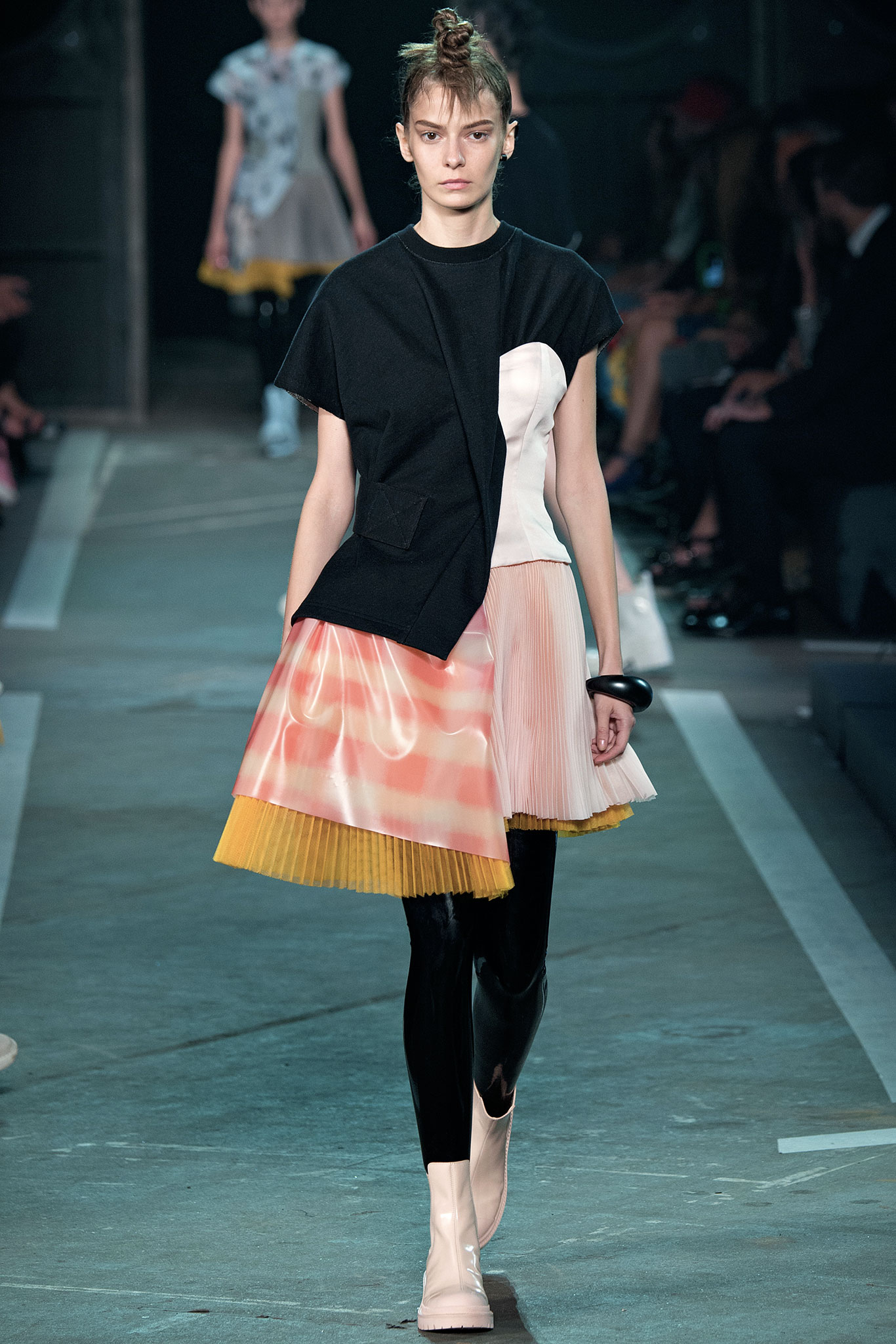
Bodice sweatshirt (bodswhirt?) by Marc by Marc Jacobs, s/s 2015, look 35, source: style.com
Fashion has been described as an “authentic hybrid”[ref] Jackson, Peter, Lowe, Michelle, Miller, Daniel & Mort, Frank (eds). Commercial Cultures: Economies, Practices and Spaces, London: Berg, 2000 and Entwistle, Joanne. The Aesthetic Economy of Fashion: Markets and Value in Clothing and Modelling, Oxford: Berg, 2009. Both describe fashion as a “commercial culture” blending cultural issues with economic concerns[/ref] – a vehicle that readily combines ideas that often seem opposed such as creativity and commerce or pop culture and high culture. Fashion has long been able to balance its right brain and left brain. Furthermore, fashion brings together individual self-expression, yet needs collective endorsement[ref]Blumer, Herbert. “Fashion: From Class Distinction to Collective Selection” The Sociological Quarterly, 10, issue 3, (1969): 275-291 amongst others[/ref]; it operates as an elitist enterprise yet measures its successes by a populist yardstick.
Viewing fashion as a fusion of opposites or contradictions, it is unsurprising then that the language of fashion should evolve to reflect this. The growing prominence of hybrid fashion nouns in runway reports and fashion commentaries makes this idea explicit – Sandaloots, a Skort, Glittens, Furkenstocks, Meggins and Trougues.
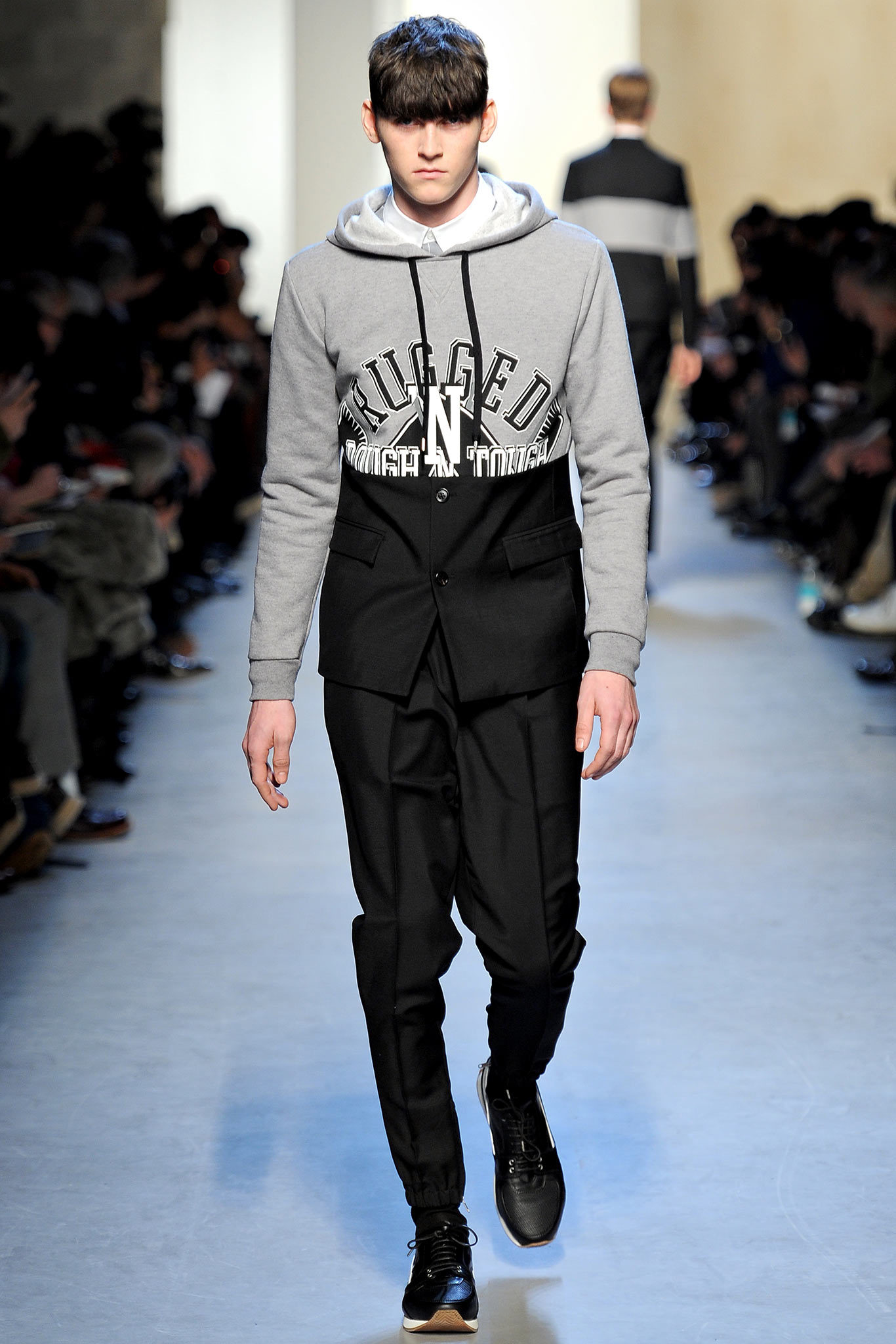
Hoodie tailored jacket (Hoodket?) by Kris van Assche, a/w 2013, look 2, source: style.com
There is a need for the language of fashion to be constantly updating and redefining itself in relation to the new clothing and changing themes of contemporary fashion[ref]Van de Peer, Aurelie. “Fashion and the new in Vogue and Vanity Fair”. Fashion- Exploring Critical Issues (1st Global Conference) Mansfield College, Oxford (25-27 September 2009)[/ref]. ‘Fashion-speak’ or ‘fashionese’ are terms that refer to some of the particularly creative terminology invented by fashion commentators as they seek to express themselves on fashion’s continual presentation of new ideas. Those at the centre of fashion’s language community (key fashion journalists and important fashion bloggers) drive fashion’s vocabulary to develop in step with the new ideas and products being presented.
Indeed, the proliferation of the hybrid (or offspring of the union of two different species) is evident in a multitude of contemporary fashionable outcomes beyond the garments themselves. Hybrid fashion retail spaces (art gallery – shop – café), business models (pro-sumers, mass customization, bricks and clicks), fashion tastemakers (designer-model-DJ) and fashion sub-cultures or street style tribes (Goth-punk-skater) to name just a few. We have also become familiar with the ‘Pug-alier’ or the ‘Labra-doodle’ as a living breathing fashion accessory. Have these dogs become popular because as consumers we just couldn’t make our minds up between these two breeds and there wasn’t room in the Louis Vuitton tote for both? Or is this reflective of bigger shifts in society?
Some may see this trend for new combinations as purely feeding fashion’s appetite for all things novel – the sartorial equivalent of a deep-fried Mars bar or Brussel sprout ice cream.
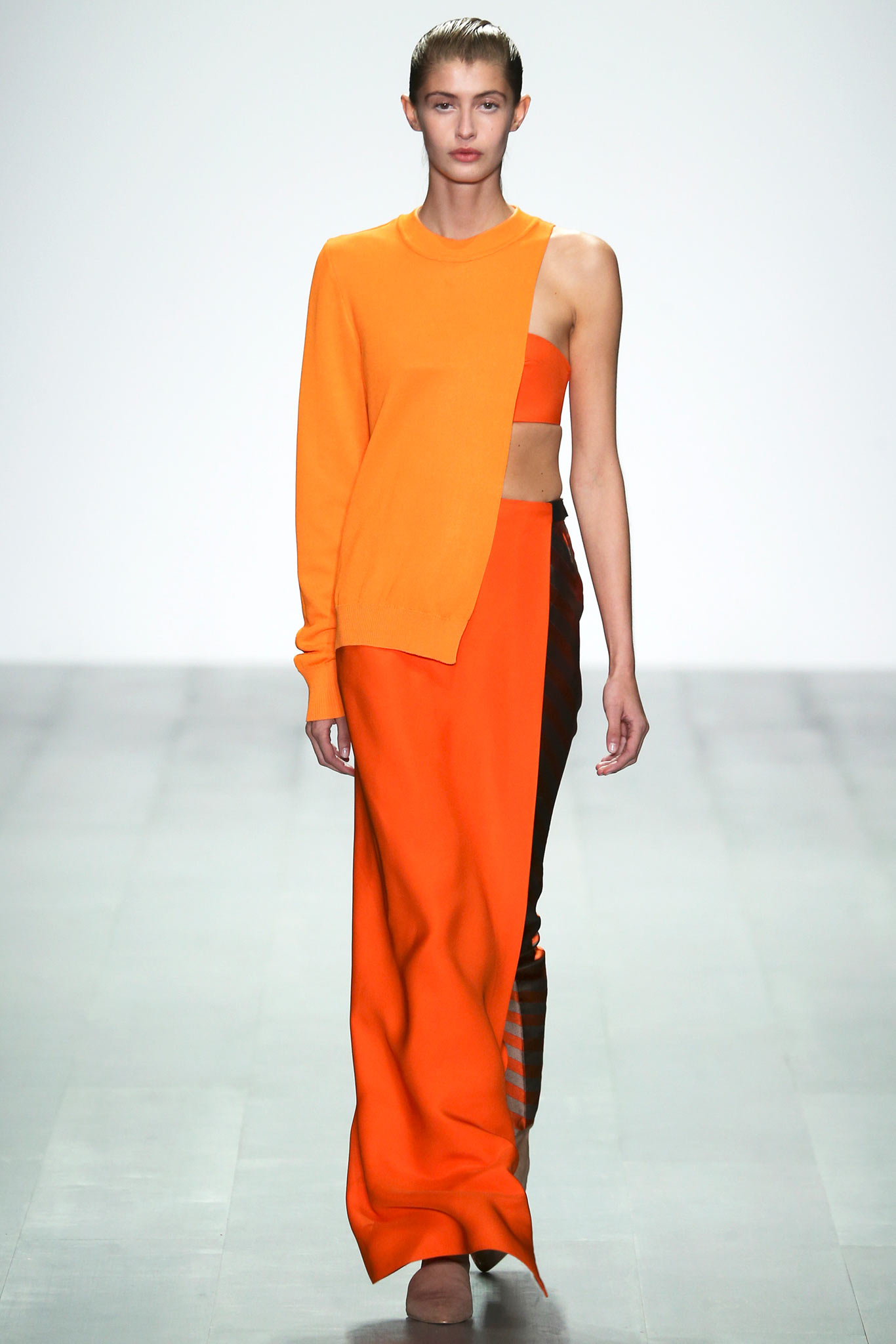
Sweater bra (swebra?) by Lucas Nascimento, s/s 2014, look 1, source: style.com
However as many fashion-cultural theorists have noted, developments in fashion have the ability to hold a mirror up to society and reflect broader cultural shifts. Through it’s creative naming process, fashion commentary has bought to my attention the notion of hybridity as a broader issue. Look outside the field of fashion and you can can see hybrid propositions in other areas too.
The theme of hybridity or dualism can be found in the way many global cities promote themselves; highlighting dual identities as a way of making them seem more attractive and vital as a destination. The dual identities come with descriptors such as ‘east-meets-west’ or at the interface of ‘ancient and modern’. This dualism is illustrated through the juxtaposition of architecture, food or lifestyle elements and proves to be a popular way to connote ‘great tourist destination’ or ‘cosmopolitan business hub’. Add into the mix the term ‘global-local’ (or glocal), and this city has something for everyone. Obviously, one needs a hybrid vehicle to get around this metropolis too. These vehicles are explicitly hybrid through their dual energy source as well as their marketing potential – addressing issues of (fuel) efficiency paired with an ethical standpoint. Again, suggesting consumers can’t make their minds up about their priorities, so they will opt for a combination of two.
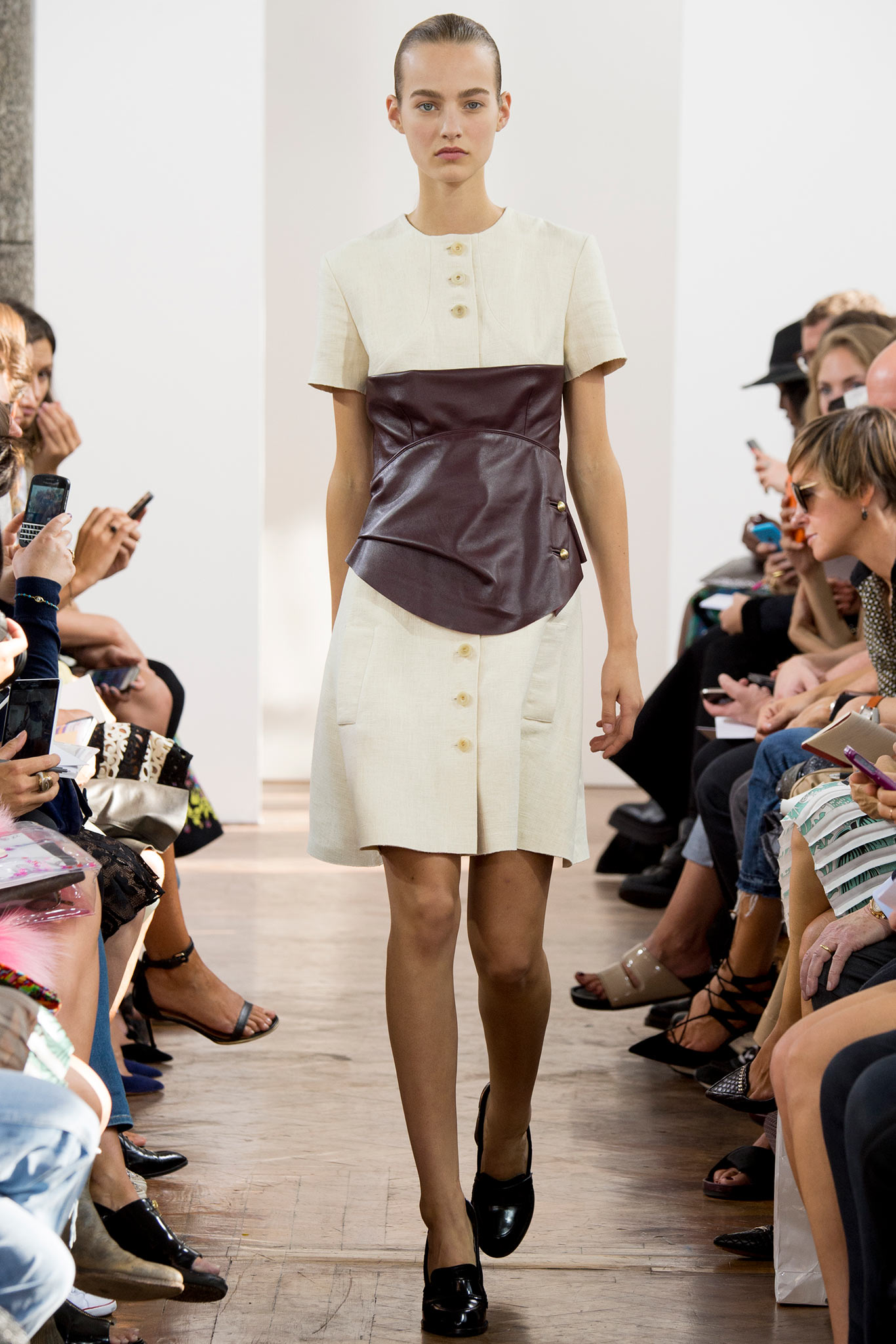
Belt bodice (beltice?) by J W Anderson, s/s 2015, look 4, source: style.com
Why is this dualism or fusion of ideas so attractive to us now? Shouldn’t this two-faced notion be confusing or disconcerting, creating an ambiguous and uncertain construction of a garment, an animal, city or business model? There is a school of thought that could perceive a hybrid as the outcome of some sort of weird experiment, having the whiff of promiscuity or unnatural union about it. However this type of negative association is not apparent today where dualism is presented as a desirable characteristic. Hybridity is a positive attribute, framed as either an efficient way to multi-task or to suggest a breadth of skills, knowledge and experience.
So I propose a reason why the hybrid maybe so appealing and meaningful to us today – the lived experience of maintaining our own hybrid identities. Many in society spend time effectively managing their own hybrid ‘selves’ – online ‘self’ and real-life ‘self’. We sit at the intersection of these two, managing credibility in both spheres. The online self is the self who adds a McQueen jacket ‘to cart’ on Net-a-Porter, while the real-life self shops at Primark. The online self can ‘Like’ exclusive restaurants in Denmark or Spain whilst the real-life self is eating beans-on-toast at home in Southend. One no longer needs to play hours of ThirdLife as an avatar to create a symbolic fantasy of yourself, wifi access, a smart phone and some carefully edited ‘selfies’ on Instagram is all it takes. These hybrid ‘selves’ offer a way to create various hybrid narratives of ourselves, becoming significant methods of constructing and controlling identity for one’s professional and personal life. Embracing hybridity in other aspects of our lives (including our wardrobes) would seem a natural step.
Who would have thought an inspired fashion fusion such as ‘trougues’ (a new footwear proposition that combines the best bits of a trainer with a brogue) could trigger such self-reflection? Thank you fashion commentators….
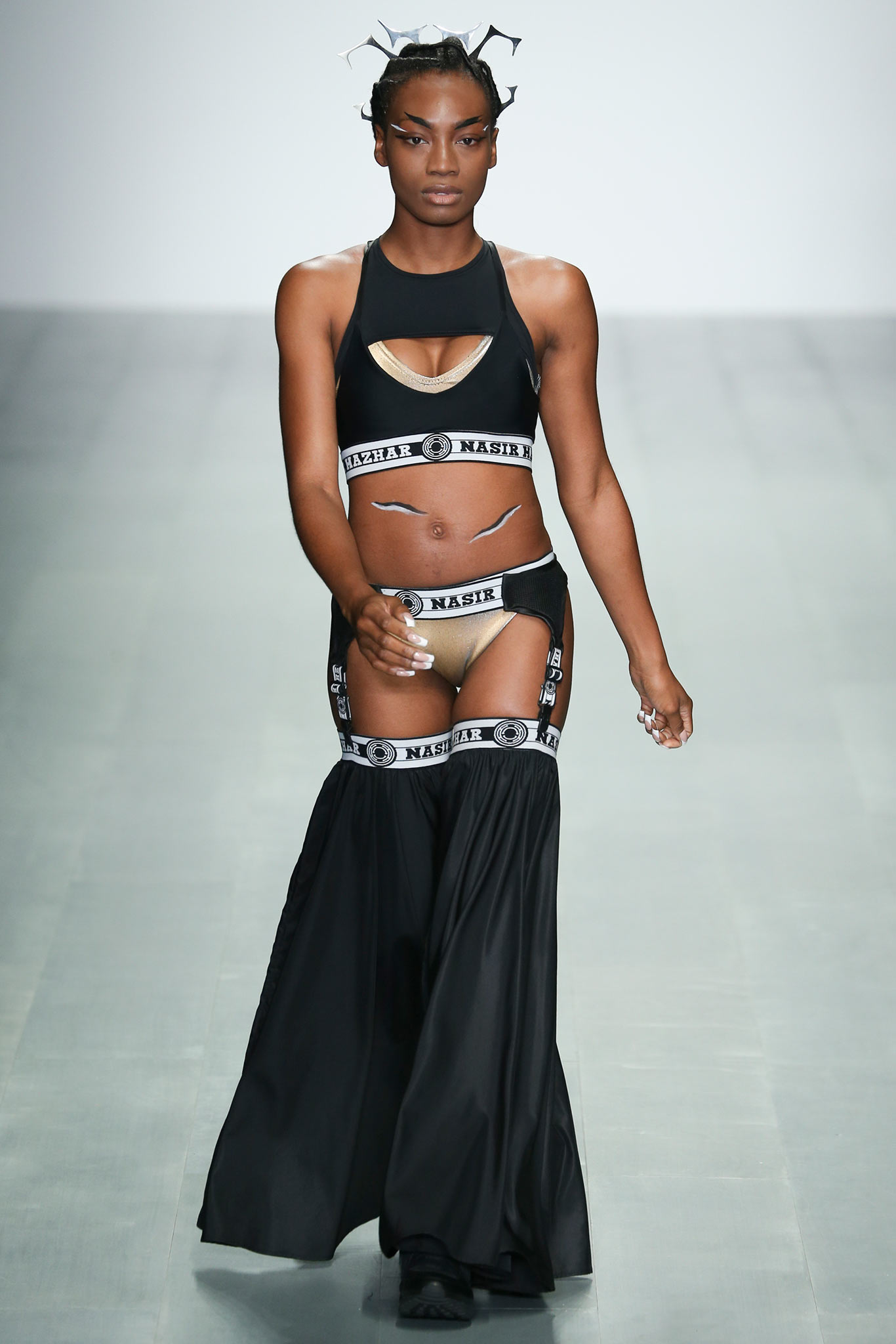
Suspender skirt (suskirt?) by Nasir Mazhar, s/s15, look 17, source: style.com
References
- Anon. “Lexicon of Fashion Terms – How to Tell your Glittens from your Trougues” The Daily Telegraph (UK) http://fashion.telegraph.co.uk/Article/TMG8778957/544/Lexicon-of-fashion-terms-how-to-tell-your-Glittens-from-your-Trougues.html, accessed 21 September 2014
- Blumer, Herbert. “Fashion: From Class Distinction to Collective Selection” The Sociological Quarterly, 10, issue 3, (1969): 275-291.
- Entwistle, Joanne. The Aesthetic Economy of Fashion: Markets and Value in Clothing and Modelling, Oxford: Berg, 2009.
- Freeman, Hadley. “How to speak fashionese” The Guardian Newspaper http://www.theguardian.com/lifeandstyle/2007/aug/17/fashion.hadleyfreeman, accessed on 20 August 2007
- Jackson, Peter, Lowe, Michelle, Miller, Daniel & Mort, Frank (eds). Commercial Cultures: Economies, Practices and Spaces, London: Berg, 2000.
- Kim, Hye Young & Ha, Ji Soon. “Korean Fashion Crossovers” International Journal of Fashion, Design Technology and Education, 3, issue 1, 2010.
- Perry, Grayson. “Being Myselves”, Style: The Sunday Times Magazine, October 5 2014
- Van de Peer, Aurelie. “Fashion and the new in Vogue and Vanity Fair”. Fashion- Exploring Critical Issues (1st Global Conference) Mansfield College, Oxford (25-27 September 2009)
Rachel Matthews
A graduate of Central St Martins and Winchester Schools of Art in the UK, Rachel’s career has been a combination of senior posts in fashion education, the fashion industry and international consultancy projects. Her academic posts have included roles at the University of the Arts London and Middlesex University. Rachel is currently head of Melbourne School of Fashion, Australia. She is undertaking a PhD at Monash University, where her research interests focus on the activities of contemporary fashion tastemakers.

